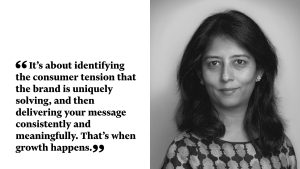A Q&A on Growth with Ashwini Pable, Director of Strategy & Business
A new proposition of Acceleration, delivered through Depth, Adrenaline and Growth.
A Q&A on Growth with Ashwini Pable, Direct of Strategy and Business.
Let’s start with a bit about you and your role with us?
It’s been an interesting journey for me transitioning from being a client of bluemarlin to working in the agency for the last 5 years. I strive to find the correct creative solutions to ensure brand objectives are met for every deliverable, and my exposure to both sides of the industry is quite unique, adding great value for all parties. Of course, I bring a cultural depth and understanding of the Indian market but also a fundamental brand understanding too.
One of the ways in which we deliver work is through adrenaline, what gives you adrenaline?
Anything which is about turning ideas into reality. I love making things meaningful, making brands purposeful and I love the idea of simplification. Adrenaline comes from giving brands a realistic reason to exist, I love new age challenges, I love to learn and provide solutions that really work and resonate with consumers.

Let’s hone in on growth, what does it mean to the businesses and brands we work on?
We should talk about growth holistically. Growth is both direct and indirect.
Direct growth is something that is attributable to the P&L when you have measurable objectives and performance vectors in the category. Indirect growth is however equally important. It’s about building a strong core for the brand. It’s about finding a meaningful foundation because when you crack the ‘why’ for a brand it starts giving an impetus meaning for all future brand growth and innovations. At bluemarlin we combine this direct and indirect thinking. Yes, it’s about being profitable but it’s also about being responsible.

More broadly what changes do you see happening in India and how is that impacting brand growth?
Socio economically we have a huge emerging middle class or what we call the ‘striver’ class. They are getting better lifestyles and better incomes in a lot of Tier 2 and Tier 3 towns that are increasingly urbanising. They don’t necessarily have many luxuries in life, but they are aspirational and looking for moments of indulgence. This demographic has rapidly growth over the last 5 – 7 years and created very exciting volumes for brands. There has also been very successful low unit pack penetration. This is about being visible and accessible to as many people as possible, and it’s a way of giving an experience to first time users because a) they might not be able to afford more and b) they don’t want to take a risk with larger volumes, this really appeals to the bottom of the pyramid. For all classes, premiumisation continues to be a huge trend in India, everyone strives for more aspirational products and services.
Of course, the economy has taken a big hit over the last 18 months so consumers are no doubt more cautious with their consumption, particularly the ‘strivers’. But interestingly we are seeing people buying less but buying better. Although their choices are driven by strong ‘needs’ rather than strong ‘wants’ they are certainly more conscious of quality and honesty. There are somethings that consumers are simply not willing to compromise on, like their health and the health of their families.
What does this mean for brands and business?
In India, the measure of growth for the longest time has been about direct commercial results. No one really spoke about why they existed as a brand and therefore what they were going to give as their value proposition to consumers. Only about 20 – 30 % of clients that we work with have a really well-defined brand. Many brands don’t understand this core link between a brand strategy and creative strategy, and it’s our job to bridge that gap. Brands must respond to this shift in consumer demands and must build in much more meaning and relevance to lives of their customers and consumers.
And why do you think this is happening?
It’s really about the exposure to information. The consumer is now very well informed and their demands for more purposeful brands comes from the sheer visibility and choice of products, particularly through e-commerce. Secondly, where there used to be a monopoly of a few players in each category there is now a booming start up culture. These new brands are challenging everything, coming up with meaningful product ideas that consumers are really latching onto it. It’s an extremely fragmented market. Consumers really want to believe in the values and have strong associations with the brand they are buying. Those incumbent monopoly brands are being forced to reimagine themselves in terms of the way that they do business, the way that they communicate and the new ways in which they need to reach consumers, physically and emotionally.

How is a business like bluemarlin able to deliver growth?
It’s about identifying the consumer tension that the brand is uniquely solving. When you get this right and deliver your message consistently and meaningfully across all touch points of the brand, that’s when growth happens. And with our flexible working model we can really cater for most specialised services, whether its brand planning or pure innovation, identity or retail or communications. We have a more holistic offering which fundamentally is about how we interact with consumers in both the analogue and digital space and in turn this leads to more integrated growth for brands too. We have a key part to play in helping to drive change and shift brand perceptions into something more purposeful.
How does growth tie into depth and adrenaline, our core other core principles that we deliver on?
If there isn’t depth you won’t get sufficient growth and if there isn’t growth, then there can’t be adrenaline. That idea of change and progress simply is adrenaline. Fortune Foods was a great example of this. We repositioned Fortune to be ‘the enabler in the kitchen’ and to help inspire creativity. The bloom symbol represented this creatively as a very strong proposition that consumers understood. For Britannia ‘Treat’ biscuit we developed a new identity based on the insight that the brand delivers ‘fun in the middle’ through its sandwiched product format. This drove the creation of characterful emojis that resonated with kids and mums allowing Britannia to recover their investment in the redesign in just 5 days through accelerated sales growth. Telling stories in interesting and relevant ways fuels both the direct and indirect growth through brand interaction in the hand, heart, and mind.

So, who should see and feel growth in the process?
Consumers without a doubt should be the first to see and feel growth. They need to understand what difference it will make to their life and that convinces them to buy, believe and experience the brand. For our clients, growth is quantified by positive metrics that indicate a healthy brand, and this gives them opportunities to innovate and to start extending their brand to find increasing relevance in consumers lives.
Want to know more? Feel free to get in touch with us on newbusiness@bluemarlinbd.com
